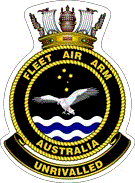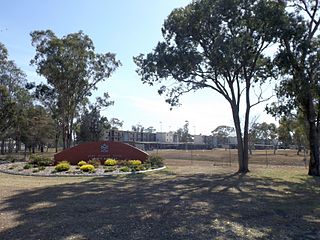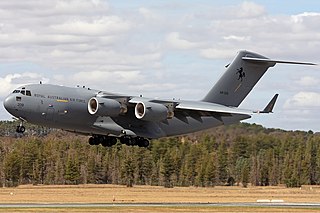Related Research Articles

The Australian Defence Force (ADF) is the military organisation responsible for the defence of Australia and its national interests. It consists of the Royal Australian Navy (RAN), Australian Army, Royal Australian Air Force (RAAF) and several "tri-service" units. The ADF has a strength of just over 85,000 full-time personnel and active reservists and is supported by the Department of Defence and several other civilian agencies.

The Fleet Air Arm (FAA), known formerly as the Australian Navy Aviation Group, is the division of the Royal Australian Navy (RAN) responsible for the operation of aircraft. The FAA was founded in 1947 following the purchase of two aircraft carriers from the Royal Navy. FAA personnel fought in the Korean War and the Vietnam War, and participated in later conflicts and operations from host warships.

HMAS Albatross is the main naval air station for the Royal Australian Navy's (RAN) aviation branch, the Fleet Air Arm. The base, located near Nowra, New South Wales, was formally established in May 1942 as Royal Australian Air Force (RAAF) base RAAF Nowra, then was transferred to the Royal Navy as HMS Nabbington in 1944, and operated as a naval air station until it was decommissioned in late 1945. In 1948, the airfield was commissioned into the RAN as HMAS Albatross, as the primary shore base for the Fleet Air Arm. Since 2011, four squadrons of the Fleet Air Arm operate from Albatross. The current commander of the base is Captain Robyn Phillips, RAN.

No. 4 Squadron is a Royal Australian Air Force squadron composed of the air force special forces Combat Controllers, aircrew who operate the Pilatus PC-21 aircraft and instructors for the Australian Defence Force Joint Terminal Attack Controller (JTAC) course.

No. 38 Squadron was a Royal Australian Air Force (RAAF) transport and training unit active between 1943 and 2018. It was formed on 15 September 1943 and saw service during World War II transporting supplies and personnel between Australia and the combat zones in New Guinea and Borneo, using Douglas Dakota aircraft. Following the war, the squadron conducted regular courier flights between Australia and Japan in 1947 and 1948. No. 38 Squadron was deployed to Singapore from 1950 to 1952, supplying Commonwealth forces engaged in the Malayan Emergency and undertaking courier flights across Asia. In 1954 it became responsible for training RAAF personnel to operate Dakotas.

Oakey Army Aviation Centre is situated approximately 3 km (1.9 mi) from the town centre of Oakey in Queensland, Australia. It provides a training establishment for Australian Army Aviation, and also hosts the Republic of Singapore Air Force's "Cougar" 126 Squadron. The Defence name for the facility is Swartz Barracks, named for prominent politician, Army Aviation advocate, and ex-POW Sir Reginald Swartz.

No. 9 Squadron was a unit of the Royal Australian Air Force (RAAF). The squadron was formed in early 1939 and saw active service in World War II as a fleet co-operation unit providing aircrews for seaplanes operating off Royal Australian Navy cruisers. It was disbanded in late 1944, but was re-raised in 1962 and later became an Army co-operation unit, flying helicopters in support of Australian troops during the Vietnam War. The squadron was disbanded in 1989 when the RAAF transferred its battlefield helicopters to the Australian Army's aviation regiments.

No. 5 Squadron was a Royal Australian Air Force training, army co-operation and helicopter squadron. The squadron was formed in 1917 as a training unit of the Australian Flying Corps in Britain, readying pilots for service on the Western Front. It subsequently became a naval fleet co-operation squadron, but was later redesignated as No. 9 Squadron RAAF before being re-formed as an army co-operation squadron during World War II. In the mid-1960s, it was re-formed as a helicopter squadron, before being disbanded in December 1989, when it was used to form the Australian Defence Force Helicopter Training School.

No. 84 Wing is a Royal Australian Air Force (RAAF) transport wing. Coming under the control of Air Mobility Group (AMG), it is headquartered at RAAF Base Richmond, New South Wales. The wing comprises No. 35 Squadron, operating Aliena C-27J Spartan transport Aircraft; No. 37 Squadron, operating Lockheed Martin C-130J Super Hercules medium transports; and a technical training unit, No. 285 Squadron.

The 171st Aviation Squadron is an Australian Army helicopter squadron equipped with S70A Black Hawk helicopters and provides support to the Special Operations Command. The squadron is based at Luscombe Airfield, Holsworthy Barracks, Sydney and forms part of the 6th Aviation Regiment.

Australian Army Aviation (AAAvn) is a corps of the Australian Army. It was formed on 1 July 1968, although it has a history dating back to 1911, when the Minister of Defence at the time, Senator George Pearce, decided there should be a flying school in the Defence Department. The motto of the Australian Army Aviation corps is Vigilance.
The 173rd Aviation Squadron is an Australian Army helicopter squadron equipped with S70A Black Hawk helicopters and provides support to the Special Operations Command. The Squadron is based at Luscombe Airfield, Holsworthy Barracks, Sydney and forms part of the 6th Aviation Regiment.

725 Squadron is a naval aviation squadron of the Royal Australian Navy (RAN) Fleet Air Arm. The squadron was originally created in August 1943 as part of the Fleet Air Arm of the Royal Navy. It initially served as a fleet requirements unit, was rerolled in August 1945 as a target towing unit, then was disbanded in December 1945. In January 1958, the squadron was re-formed, as a fleet requirements and communications unit of the RAN, operating a variety of fixed-wing aircraft. The squadron was redesignated as an anti-submarine warfare training squadron in May 1959, then was decommissioned in May 1961 and absorbed into 724 Squadron. 725 Squadron was recommissioned in November 1962 as an operational anti-submarine helicopter squadron, flying the Westland Wessex. During this commission, the squadron was involved in HMAS Sydney's troop transport voyages, the rescue of personnel following the Melbourne-Voyager collision, and the Operation Navy Help Darwin relief effort post-Cyclone Tracy. The squadron was decommissioned in December 1975. 725 Squadron was commissioned for the fourth time in June 2015, this time as a training unit for MH-60R Seahawk Romeo helicopters: the squadron had been reactivated two years prior as a non-commissioned unit train on and accept into service the Romeos.

Women currently make up 19.2% of the ADF workforce. Women have served in Australian armed forces since 1899. Until World War II women were restricted to the Australian Army Nursing Service. This role expanded in 1941–42 when the Royal Australian Navy (RAN), Australian Army and Royal Australian Air Force established female branches in which women took on a range of support roles. While these organisations were disbanded at the end of the war, they were reestablished in 1950 as part of the military's permanent structure. Women were integrated into the services during the late 1970s and early 1980s, but were not allowed to apply for combat roles. In January 2013, serving women were allowed to apply for all positions in the Australian Defence Force (ADF) except special forces which became open to women in January 2014. In January 2016, civilian women became able to direct entry to all positions.

The Australian Defence Force Basic Flying Training School (BFTS) was located in Tamworth in northern New South Wales. It was run by BAE Systems Flying Training Academy, which conducted tri-service flight screening and basic flying training for the Australian Defence Force (ADF) aircrew from the Australian Army, Royal Australian Navy (RAN) and the Royal Australian Air Force (RAAF) using CT-4 Airtrainer aircraft.

Fairbairn, formerly RAAF Base Fairbairn, is a former Royal Australian Air Force (RAAF) military air base, located in Australia's national capital, Canberra, Australian Capital Territory. Over the years the name of the establishment, and the use of the land, has changed. The base was in use by the RAAF between 1940 and 2007, when the land occupied north and east of the Canberra Airport runways was sold to Capital Airport Pty Limited for the purposes of advancing civil aviation and the development of a business park.

The first involvement Australia had with naval aviation was in 1911, when an Australian-born Royal Navy officer became one of the first four naval officers to receive pilot qualifications. During World War I, the Royal Australian Navy (RAN) experienced several forms of airborne operation, with HMAS Brisbane operating a seaplane, while HMA Ships Sydney and Australia were used for experiments with aircraft launch platforms. An aircraft embarked aboard Sydney was also involved in one of the first naval air battles. Several Australians also flew as part of the Royal Naval Air Service.

The Royal Australian Air Force (RAAF) operates eight Boeing C-17 Globemaster III large transport aircraft. Four C-17s were ordered in mid-2006 to improve the ability of the Australian Defence Force (ADF) to operate outside Australia and its region. The aircraft entered service between November 2006 and January 2008, the second pair being delivered ahead of schedule. Two more Globemasters were ordered in 2011, the sixth being delivered to the RAAF in November 2012. Another two C-17s were ordered in October 2014, with the final aircraft being delivered in November 2015. The Globemasters are built to the same specifications as those operated by the United States Air Force (USAF), and the Australian aircraft are maintained through an international contract with Boeing.

The Australian Defence Force has operated Boeing CH-47 Chinook heavy-lift helicopters for most of the period since 1974. Thirty of the type have entered Australian service, comprising twelve CH-47C variants, eight CH-47Ds and ten CH-47Fs. The helicopters have been operated by both the Royal Australian Air Force (RAAF) and Australian Army.
References
- Citations
- ↑ "Units stationed at Fairbairn". The Canberra Times. 3 April 1990. p. 16. Retrieved 11 February 2018– via National Library of Australia.
- 1 2 "From bombers to VIP jets". The Canberra Times. 3 April 1990. p. 16. Retrieved 11 February 2018– via National Library of Australia.
- 1 2 Australian Army Flying Museum, Oakey 2015, p. 5.
- ↑ "Fairbairn to lose helicopter school". The Canberra Times. 30 May 1991. p. 2. Retrieved 11 February 2018– via National Library of Australia.
- 1 2 3 Joint Standing Committee on Public Works 2001, p. 5.
- ↑ "RAAF Fairbairn plaque dedicated in Memorial Grove". RAAF News. Department of Defence. February 2002. Retrieved 11 February 2018.
- ↑ "ADF Joint Helicopter Aircrew Training School commences training". Australian Aviation. 17 January 2018. Retrieved 24 February 2018.
- Works consulted
- Joint Standing Committee on Public Works (2001). "Redevelopment of the Army Aviation Centre Oakey, Queensland". Parliament of Australia.
- Australian Army Flying Museum, Oakey (2015). "Army aviation in Australia 1970–2015" (PDF). Australian Army. Archived from the original (PDF) on 24 March 2017. Retrieved 11 February 2018.